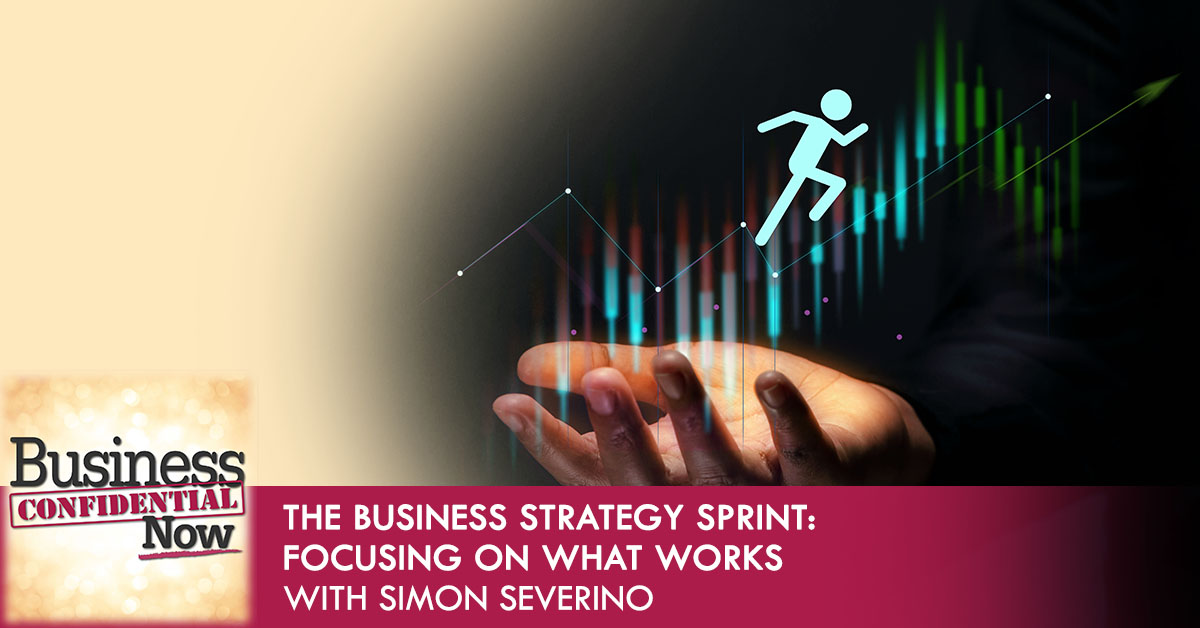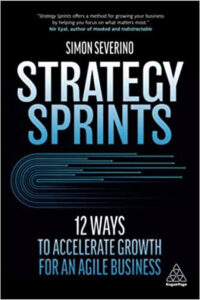
Photo Credits: © iStock | Black Salmon
A Strategy Sprint helps business leaders create value. Discover how simplifying and systematizing your operations can free up time and energy that lets you focus on your zone of genius.
Join Hanna Hasl-Kelchner as she talks to the author of Strategy Sprints: 12 Ways to Accelerate Growth for an Agile Business and the Founder of Strategy Sprints, Simon Severino.
What you’ll discover about Business Strategy Sprint
- How a business strategy sprint can help build more independent teams
- Why you can improve your ability to delegate specific processes with a business strategy sprint
- How a business strategy sprint helps you get greater clarity about your core business processes
- Why a business plan differs significantly from a business strategy sprint
- And MUCH more
About Simon Severino
 Simon Severino helps business owners in SaaS and Services run their companies more effectively which results in sales that soar. Trusted by Google, Roche, Consilience Ventures, Amgen, and AbbVie.He created the Strategy Sprints™ Method that doubles revenue in 90 days by getting owners out of the weeds. Simon is also a TEDx speaker, a Contributor to Forbes and Entrepreneur Magazine, and a member of the SVBS Silicon Valley Blockchain Society.
Simon Severino helps business owners in SaaS and Services run their companies more effectively which results in sales that soar. Trusted by Google, Roche, Consilience Ventures, Amgen, and AbbVie.He created the Strategy Sprints™ Method that doubles revenue in 90 days by getting owners out of the weeds. Simon is also a TEDx speaker, a Contributor to Forbes and Entrepreneur Magazine, and a member of the SVBS Silicon Valley Blockchain Society.
Related Resources
- Strategy Sprints: 12 Ways to Accelerate Growth for an Agile Business
- Strategy Sprints
- https://Podcasts.Apple.com/us/podcast/strategy-sprints/id1299008831
- https://www.Facebook.com/strategysprints/
- https://Twitter.com/strategysprints
- https://www.Instagram.com/strategysprints
- https://www.LinkedIn.com/in/simonseverino/
- https://www.YouTube.com/channel/UCnSFgJd0CrsEdQdO21txR2A
If you liked this interview, you might also like these Entrepreneurship episodes.
—
The Business Strategy Sprint: Focusing On What Works With Simon Severino
Business Strategy Sprints sounds like a cross between a relay race at an MBA class that you could pull a muscle in and go broke at the same time. Our guest says that strategy sprints are the way to go if you want to grow your revenue and scale your business without sacrificing your personal life. He claims it’s all about working smarter, not longer. We will see if he can put some meat on that old cliché.
—
I’m delighted to welcome a very special guest. He’s Simon Severino, author of Strategy Sprints: 12 Ways to Accelerate Growth for an Agile Business. Simon helps business owners run their companies more effectively and created this strategy sprints method to do exactly that, doubling revenue in 90 days by getting owners out of the weeds. He has been a TEDx speaker and a contributor to Forbes and Entrepreneur Magazines. I’m excited to have him with us to enlighten us about these Strategy Sprints. Welcome to the show, Simon.
I’m excited to be here.
This idea of business Strategy Sprints sounds a bit intimidating and exhausting all at the same time. Help me understand what it is and how it differs from a business plan.
There’s a huge difference, and the impact is also the opposite. The sprint gives back time and freedom actually by reducing the number of activities per week. The difference to a business plan is what is a strategy as opposed to a business plan. A business plan is a list of activities. A strategy is something that tells how you are going to win and in which way you are going to win. That’s not on that list.
A business plan is only a list of activities. On the other hand, a strategy tells you how you can win. Share on XAfter you have a strategy, you might do a list if you still want to do or you just execute it in sprints which we advise for. When we coach entrepreneurs, and it’s 21 years that we have coached them, the last 5 years have been with the Strategy Sprints methods because we have distilled it to make it simple and work.
The core of a business, especially if you are a very small business like people reading now. If you are a small business, how can you prepare for 2023? There is your core, and that’s the most important thing, and then there are projects but your core is a process. The process is made of six simple elements, and that’s what we focus on when we coach people.
The core value creation process. That is awareness, engagement, closing them, delivering, and retaining people. Those are simple elements of your business, and in each stage, you want to create value. Why do I call it a process? It should work whatever the weather is, however you feel independently of you or independently of single people because they can go on holidays. They can get sick and can change roles.
A process is something that works under all weather conditions and whatever happens. Even while you sleep, the process is working. That’s the opposite of working a lot. While we are talking, I have my core processes running in many different time zones, and they are creating value but are not dependent on me.
I can hang out on podcasts. I can play with my kids. I can have long walks in nature, which I love to do but the core processes are creating value. That’s the Strategy Sprints method. You have a core process of how you create value, and that is self-correcting and self-healing, and it’s working like clockwork independently of people.

Business Strategy Sprint: “The Sprint’s method” is all about having your core process create value. It is self-correcting and self-healing that works like clockwork independently of people.
When we found stuff, we are passionate about it, and we are the business. We are the delivery, the marketing department, and even the IT department. We must protect our time and energy because we can burn out quickly. It’s about simplifying and systemizing the core. When you have done that, then you will have projects on improving single parts of it. The project can be about how we can get more people on the phone or close more people. Those can be projects but the core needs to be a system, meaning it works whatever happens.
I understand the overall concept, and it makes a lot of sense. I can see how that would be very productive but I also have a feeling there could be some folks scratching their heads saying, “I’m doing that but I’m still doing everything.” I understand that by your definition, that means they are doing it wrong. For someone who wants to create or look at these core processes, could you give us an example to make this concept more concrete? What would be a good core process to start with?
One of the people in our coaching program runs a marketing agency. The first thing that we did in week one was to simplify those elements of awareness, engagement, closing, delivering, and retaining. Of all the things that she did, she picked only the winners. Marie condoned her business with her. She just kept what’s sparking joy, so one marketing channel. One way of bringing people into a quiz. One way of closing from there and selecting our clients, and then one delivery mechanism, and we simplified all of that.
We started mapping out all the activities, and there is a daily, weekly, and monthly habit. The daily habit question is, “Which of the tasks that you did now can you delegate?” She said, “Scheduling.” We said, “Can software do this or a person?” We picked the software, and now she has freed up time from scheduling. The software does the scheduling for her.
We went through one task after the other. After 2 months, she had freed up 16 hours per week of her time and that compound. In this week, you have sixteen more hours to do stuff that you enjoy doing. It can be higher leverage sales. Things like venture partnerships or writing a book. It can be enjoying life and working out or enjoying your family. For her, it was spending more time with her kids. Week by week, we helped her identify things that can be delegated either to software or a person, and we did that with her team. Now the whole team has picked up tasks from her, and she has much more freedom.
That’s a great example. Thank you, Simon. I appreciate your sharing that. Part of this Strategy Sprints that you talked about is having it be self-healing. If a hiccup happens and she’s off doing other higher-value things that give her joy, how do they become self-healing?
I study different industries than mine to come up with that, and most of the self-healing and self-correcting mechanisms you can actually study in your garden. If you have a garden or nature nearby, you can study self-healing mechanisms and self-correcting mechanisms at work. I get my inspiration for several years from nature, and I think, “How can I do this in my business activities?”
For example, costs, which is a very important thing to talk about. We have a recession coming up. What’s the best way of reducing costs? The best way is to change the contracts with all your suppliers or employees, the biggest costs positions to have them more resilient. What is the greatest self-healing mechanism in cost? When you have zero work, you have zero costs, and when you have a lot of work, you have more costs but you pay from the profits, not from the revenues. Let me give you some examples.
When you have zero work, you have zero costs. But when you have a lot of work, you have more costs. Share on XOur clients are going through the cost positions. The main positions are buildings. You go remote. That’s easy to do. The next biggest position is an employee. How many of them are you paying for their time, and how many are you paying for their results? For example, my own business. I am not paying people to work with me right now. They are paying to work with me. It’s a certification model, so there are ways that are resilient and self-healing.
It’s like a franchise. They pay per month to be an active certified Strategy Sprints coach. If I would have zero sales next month, I would have zero operational costs except for a little bit of software. If I had ten times more, then I would have also ten times more costs, which is fine because I’m paying that from the profits. It’s limitless in scalability upwards but there is a clear limit downwards. That is a resilient system, and every garden is like that.
My garden has a lot of weeds in it so that’s resilient in the wrong direction. How do you keep the weeds from happening? One thing to say is that we go from employees to software but software has glitches and doesn’t work. There’s the server is down or pieces of the internet are down. You could be substituting one problem for another. What do you think about that?
Weeds are extremely resilient. I have peppermint in the garden, and some years somebody from my family says, “Let’s get rid of the peppermint. It’s coming back.” They are very resilient, and the software is reliable. There are minor bugs that can be quickly fixed. Our software never gets viruses. It doesn’t go on holiday. It’s reliable and works 24/7.
Reliable software never goes on holiday. Share on XThe resilience, let’s have an example from one of your suppliers. Let’s say you have a PR agency, and you are paying them thousands of dollars to get you into newspapers. Many people have a contract that says, “I give you $1,000 per month. Bring me into newspapers.” That’s the worst thing you can do. A much better thing is to define with them what you want to achieve.
For example, “I want to be in the Wall Street Journal, and that’s worth $3,500. I want to be in the New York Times, and that’s worth $29,000 for me. You get me there. I will pay.” These are performance-based contracts. If you do this with your PR agency and material suppliers, go through all cost positions and see how you can redefine them around the results and performance.
Now you have derisked. Maybe at the end of the year, you will pay the same amount for your PR agency but you have derisked because you only pay it if it really happens. You have somebody doing Facebook ads for you. Pay them 15% of the profits instead of a monthly fixed fee. They will be on their toes and will work better.
You will have to talk to twenty possible partners before you find the right ones. When you find the right ones, they will have the confidence, the skill, and also the willingness to really create results for you and with you because now your partners. You share both the risks and the profits. That’s a real business partnership.
Even having people think about their different costs, maybe there are some they are not ready to flip the way that you’ve described and turn into partnerships or don’t know how yet. Even starting with certain ones could be an improvement over what they have, so I get that. Let me ask you this. The whole concept of Strategy Sprints sounds like a great idea, and there’s value to be had. Even if we have some skeptics reading saying, “I can’t do that with my business,” step outside the box for a moment and try to evaluate where you might be able to take that little baby step that would already progress. Why do you think that more businesses aren’t even trying to do something along the lines of Strategy Sprints? What’s holding them back?
Everybody is in a different situation. I am actually feeling with most business owners who go, “There will be a recession. What is really working and what’s not?” That’s a good question to ask yourself. Stay with what is healthy in your business and let go of the rest. Do less activities, focus on the things that are working, and put in more attention and love like gardening. Bring every day a little bit of water to the things that work and don’t spend so much effort on the things that don’t work. If you have something that works, that’s actually your asset. That’s what’s worth putting more attention into, improving, and systemizing. If you can systemize that, it will be more resilient next year.

Business Strategy Sprint: Ask yourself what is healthy in your business and let go of the rest. If you have something worth putting more attention into, you can improve and systemize it to become more resilient.
If you want to try the daily flow where you write down, “What did you do now? What can you delegate next?” you can download it for free on StrategySprints.com. It’s a good investment of five minutes of your time if you do that review because you will identify things where you might want to systemize, outsource or delegate next. That’s good exercise for everybody.
That’s great, and I appreciate your sharing that resource on your website. That’s good to know. In your experience, where do businesses run into problems or resistance? I know they are not being as resilient as you would like but where do they run into issues implementing the Strategy Sprints?
They get an assignment from their Sprints coach, and then they go, “Do I need to do this? I don’t have time.” Write down your business vision in three years where you be like, “Come on, Sprints coach, do I need to do this? I don’t have time for this,” and then the Sprint coach explains why, and then they do it reluctantly. They put in half an hour.
After three hours, they are still writing their vision and so in the flow of it that they don’t even want to stop and go, “Thank you, Sprints coach, for this assignment. It’s amazing. I now have clarity about what we stand for, who we want to attract, what’s the change we want to invoke in the people that we work with, and how they look when they go home when they are proud of their results.”
They are totally energized after the assignment but before the assignment, they always go like, “I don’t have time for this.” It’s a fun thing to see, and it’s similar to athletes and their coaches. As a coach, the art is always to be a very good listener and see where they are but also to kick them out of their comfort zone for this couple of inches that they are ready to grow. A good coach sees where they are and what the growth opportunity is. It helps make that little breakthrough. Nowadays, we have many of these mini-breakthroughs, and they always start with resistance with, “Do I need to do this?”

Business Strategy Sprint: A good coach can kick you out of your comfort zone so you can grow. They can also pinpoint growth opportunities that will allow you to break through today.
Do you find that people are not that familiar with or have somehow internalized what their vision is and assume that they know it as they haven’t committed it to writing or shared it with somebody verbally that they are missing some of the details of it?
We do what we do and see what’s in front of us. Somebody else comes and says, “Yeah, but you should be two levels above fulfillment.” I say, “What? I don’t even know what that means,” but they see where I can be, so they will push me a little bit. They will say, “Come on. Delegate one thing now.” I say, “I’m going to delegate one thing. The bookkeeping.” I then feel, “Delegating a thing gave me two hours back of my life. Yes, coach. Now I get it. Please give me the next assignment.”
There’s a little bit of a trust issue and fear of letting go. Is that what you discover?
Yeah. Before you know that it can work, you don’t trust it. I remember my business coach telling me, “You have to fire yourself from operations.” I was like, “What? I am the operations. I am the coach. I am the delivery. How can I fire myself? Who does that?” “You will find out but first, you have to fire yourself. You are the bottleneck,” and I was like, “I don’t know what you are talking about,” but he was right. When you are in the thick of it, you see the trees. You don’t see the forest. Coach from the outside sees the forest and pushes you a little bit. That’s the dynamic and what’s helping us entrepreneurs to build great stuff but then also to let go and find a higher leveraged and easier way to scale.
When you are in the thick of things, you can just see the trees while a coach can see the forest. Share on XIn your book Strategy Sprints: 12 Ways to Accelerate Growth for an Agile Business, I want to talk for a minute, and I’m curious about what you think the most important thing is that you would want your readers to take away from your book.
The book starts with a foreword from one of our clients, Anthony Iannarino. He’s sharing his own Sprint and how he had a business that was totally dependent on him. How Sprint helped him realize and execute a team that works less dependent on him so now he could then focus on his zone of genius, which is speaking and being on stage. That’s what he loves.
Meanwhile, he wrote three books since the Sprint. That’s how much time he could liberate for himself. He enabled and empowered the three freelancers that he had to run the whole sales, marketing, and operations. Even if he had zero fully employed people when he Sprinted, he managed in 90 days to systemize all the processes in a way that they can run without him. He can pick and choose the tasks of the week and pick and choose based on his strength in the stuff that he loves doing. He said, “I’m now in my zone of genius. I’m on stage. I love it.”
If it helps you get in your zone of genius, then you want to check this book out and consider doing a Strategy Sprints to help you work on your business instead of only in your business. Thank you so much, Simon. This has really been a fascinating look into business Strategy Sprints. Thanks for all you do to help businesses scale, grow their revenue, and give business owners and entrepreneurs their freedom. Thanks so much for reading. Please be sure to tell your friends about the show and leave a positive review. We will be back next time with another episode of Business Confidential Now. Until then, have a great day and an even better tomorrow.
Join, Rate and Review:
Rating and reviewing the show helps us grow our audience and allows us to bring you more of the rich information you need to succeed from our high powered guests. Leave a review at Lovethepodcast.com/BusinessConfidential
Joining the Business Confidential Now family is easy and lets you have instant access to the latest tactics, strategies and tips to make your business more successful.
Download ♥ Follow ♥ Listen ♥ Learn ♥ Share ♥ Review ♥ Comment ♥ Enjoy
Ask Questions or Recommend a Topic/ Guest:
- Use our convenient Get in Touch form
- OR e-mail feedback(at)BusinessConfidentialRadio.com
Disclosure:
This post may contain links to products to products on Amazon.com with which I have an affiliate relationship. I may receive commissions or bonuses from your actions on such links, AT NO ADDITIONAL COST TO YOU.
